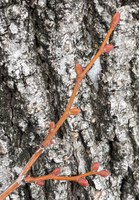Dakota Gardener: Technically speaking
(Click an image below to view a high-resolution image that can be downloaded)
By Joe Zeleznik, forester
NDSU Extension
This semester, I’m teaching an on-campus class called River and Stream Resource Management. I’m having a blast with the class, but I’m struggling a little with some of the terminology. I’m a forester and a lot of the material is new to me. If you can explain “entrenchment ratio” to me, I’d appreciate it.
Technical terms can be tricky, but they’re incredibly important as they allow us to communicate very clearly and specifically. If you and I are using a term that has a different meaning for each of us, then we’re not really communicating. In my work with Extension, I often have to translate technical terms into easier-to-understand descriptions. It can be challenging but it’s fun.
That said, here are a few of my favorite technical forestry terms, along with some not-so-technical translations.
Kerf – This is the empty space left in a log or a board by cutting it with a saw. Kerf can also be used to describe the width of that cut. It’s important to know the kerf of a saw cut when processing wood, because this material is lost. When I need a board to be 48 inches long, it better not be 47 7/8 inches or less.
Breast height – The standard location for measuring the diameter of the tree stem is called “breast height” and is set at 4.5 feet above the ground. That’s in the United States. In many other countries, breast height is standardized at 1.3 meters (4.26 feet), while in other places 1.4 meters (4.59 feet) is used. It’s important to be consistent in our measurements, as they allow us to compare one tree to another.
Why do we even measure the diameter of the stem? Let’s go back to high school geometry for that one. From the diameter of a circle, we can calculate its area. And the area of a tree stem is directly proportional to the area of the crown. When we add up the area of the tree crowns in a given area, we can determine the density of the stand.
What is a stand? What about a crown? Is that the same as canopy?
It can get very confusing, very quickly.
Just so you know, crown and canopy are different, though related, terms. Individual trees have crowns. Groups of trees – stands – in a forest have a canopy. Does that make sense?
The botanical terminology of tree identification can be pretty complicated as well. Shapes are especially challenging.
Inequilaterally ovoid – This term describes the shape of the buds on an American linden (basswood) tree. Lateral means side-to-side. Ovoid means egg-shaped. In less technical terms, this translates to “a lopsided egg.” Most students seem to understand that description.
Obovate – The opposite of ovate. Ovate is the two-dimensional equivalent of ovoid. Again, picture an egg. It’s wider at one end – we’ll call it the bottom – than the other end. The opposite of that would be an oval-like shape that’s wider at the top. The word obovate describes the shape of chokecherry leaves. They’re not egg-shaped but instead are the opposite of egg-shaped.
Specifically, if we’re looking at a chokecherry leaf from above, going from the base of the leaf to the tip, the widest point is closer to the tip than to the base. Next summer, when you’re picking chokecherry fruits, check out the leaves and see if they’re obovate.
Do we really need to learn these terms? Will they make a difference in our daily lives? Probably not, but technical terminology does help with communication, especially when describing tree species and for professionals working with tree measurements. And if nothing else, knowing a few of those technical terms might help you win the next time you play Scrabble or Words With Friends.
NDSU Agriculture Communication – Feb. 7, 2023
Source: Joe Zeleznik, 701-730-3389, joseph.zeleznik@ndsu.edu
Editor: Kelli Anderson, 701-231-6136, kelli.c.anderson@ndsu.edu




